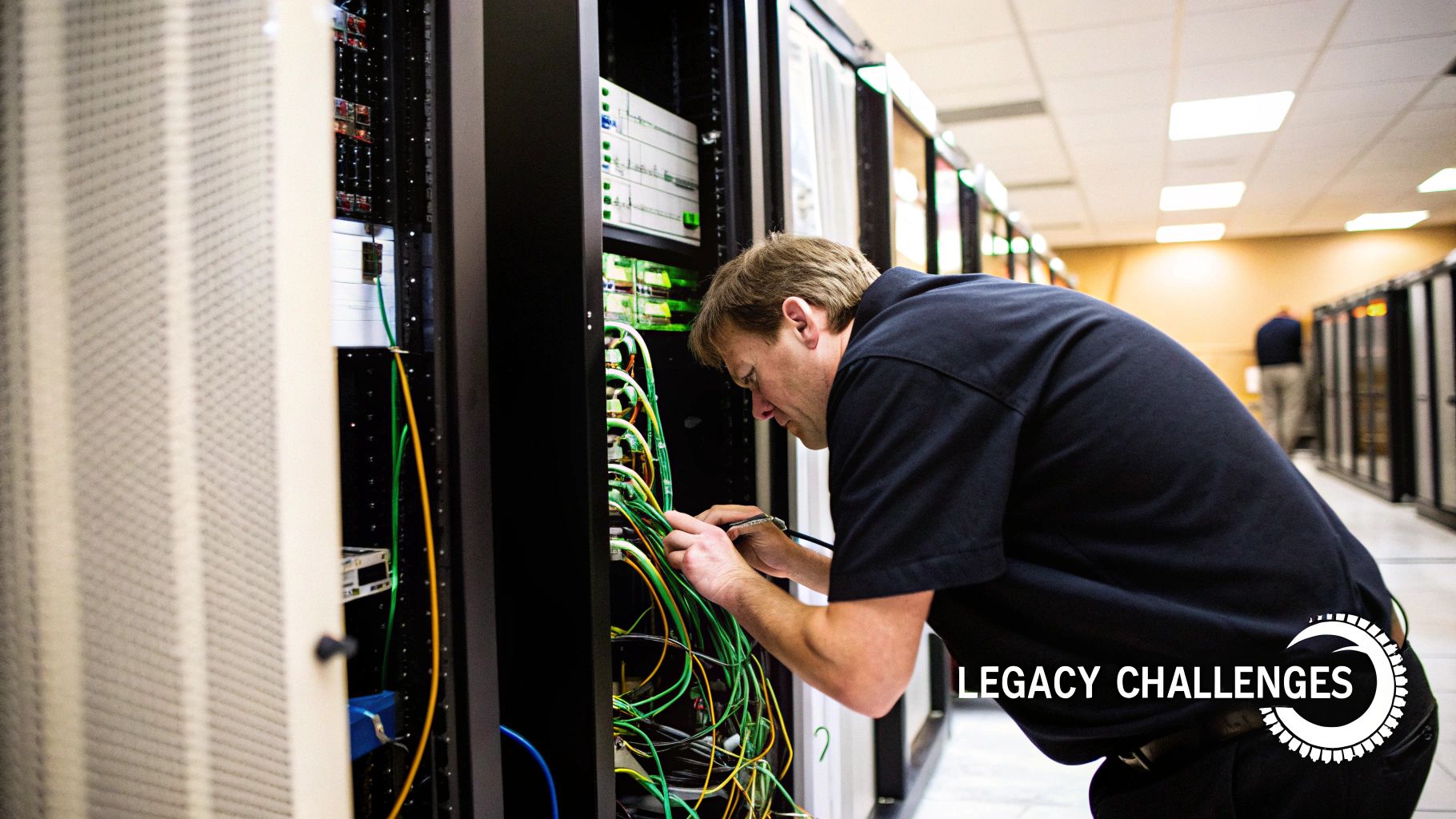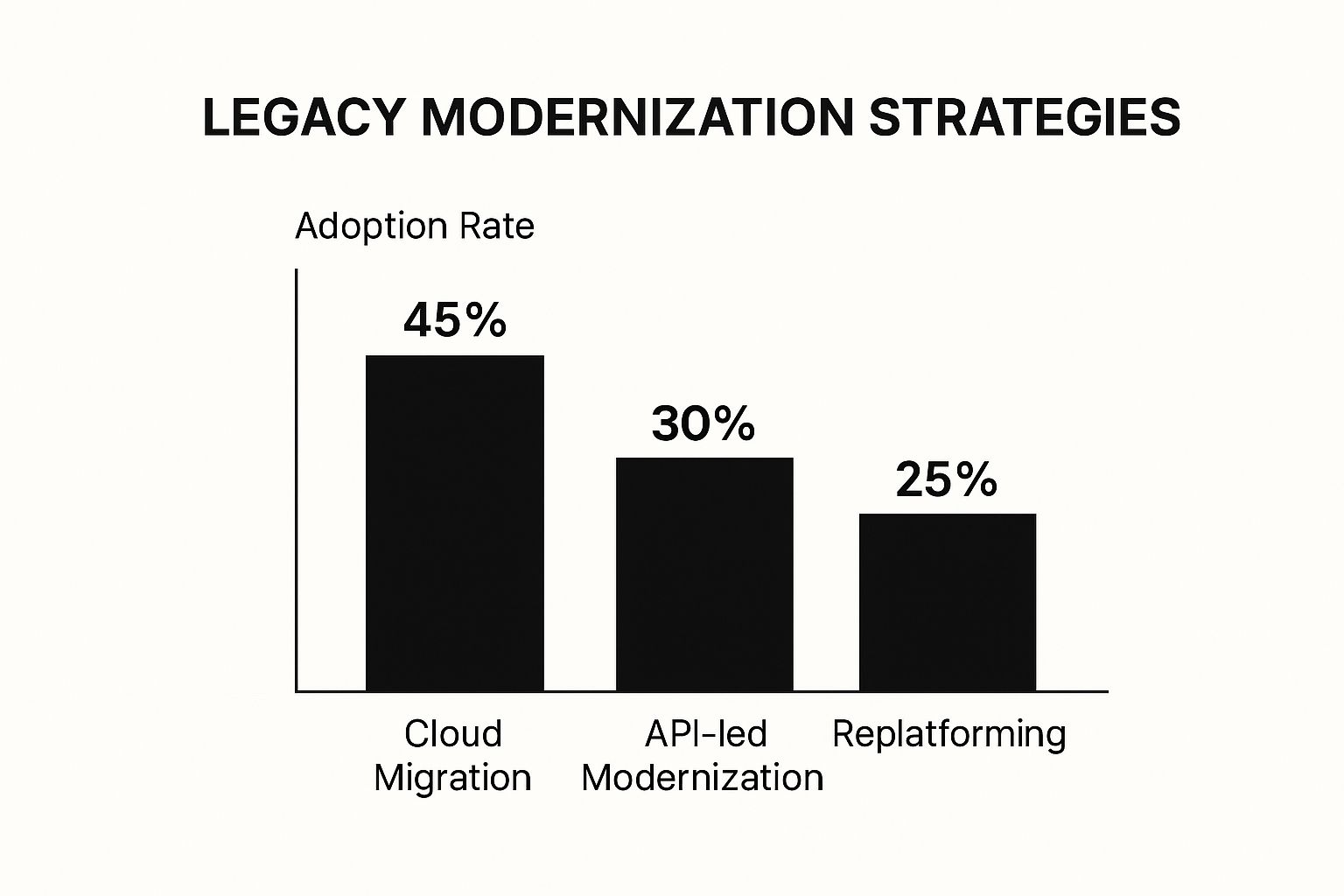Understanding Legacy System Modernization In India
Modernizing legacy systems is no longer a luxury, but a business necessity in India. While your existing systems may have served you well, they could be hindering your ability to innovate and adapt to today’s rapidly evolving market. Holding onto outdated technology can lead to higher costs, security vulnerabilities, and lost opportunities.
Challenges and Opportunities of Modernization in India
Indian enterprises encounter specific challenges regarding legacy system modernization:
- Budget Constraints: Modernization projects can be expensive, demanding substantial investment in new technologies and skilled professionals.
- Skill Shortages: Locating professionals with the necessary skills to manage and implement modernization initiatives can be a struggle.
- Resistance to Change: Internal hesitation to embrace new technologies and processes can impede progress.
However, these challenges come with significant opportunities. Modernization can unlock several benefits:
- Improved Efficiency and Productivity: Streamlined operations and automation can significantly increase productivity and decrease operational expenses.
- Enhanced Agility and Innovation: Modern systems allow businesses to respond more quickly to market fluctuations and encourage innovation.
- Increased Security: Updating systems strengthens your security and helps protect against emerging cyber threats.
For example, consider a manufacturing company using an outdated inventory management system. Modernizing this system could automate inventory tracking, optimize supply chains, and minimize waste, resulting in significant cost savings and greater efficiency. The India application modernization services market is growing considerably as organizations transform their legacy applications into modern, efficient systems. This growth is driven by the need for improved performance, security, and user experience, all vital for staying competitive.
Learning from Successful Indian Companies
Many Indian companies have successfully managed the complexities of legacy system modernization. These success stories offer valuable lessons for other organizations starting similar endeavors. Some companies have implemented phased approaches, beginning with smaller projects to gain momentum and demonstrate value. Others have prioritized building internal capabilities and cultivating a culture of change management. Learn more with this resource: Modernizing Legacy Systems: A Guide for Indian Enterprises
Key Considerations for Modernization in India
When planning a modernization project, Indian businesses should consider these factors:
- Regulatory Landscape: Ensure your project complies with all relevant regulations and data privacy laws.
- Infrastructure: Assess your current infrastructure and prepare for any required upgrades or cloud migration.
- Cultural Factors: Address potential cultural barriers and encourage user adoption through clear communication and training.
By carefully considering these factors and learning from the successes of other Indian organizations, businesses can create effective modernization strategies that deliver long-term value. Understanding the unique context of the Indian market is essential for achieving legacy system modernization success.
Why Asia Pacific Is Leading The Modernization Wave

India's modernization efforts are not isolated. They are a key part of a larger, rapidly evolving trend across the Asia Pacific region, which is quickly becoming the global center for legacy system modernization. This regional transformation offers substantial opportunities for Indian businesses. But what's fueling this change, and how can your company take advantage of it?
Market Trends and Government Initiatives
Several factors contribute to the Asia Pacific region's leading role in modernization. First, there's a growing awareness of the limitations of outdated systems. Many businesses in the region are finding that relying on legacy technology hinders their competitiveness in today's rapidly changing market.
Second, governments across the region actively promote digital transformation initiatives. These initiatives often provide incentives and support programs for businesses undertaking modernization projects, creating a positive environment for investment and innovation.
Finally, the Asia Pacific region is experiencing a significant increase in technology-focused venture capital funding. This influx of capital drives the development of new modernization solutions and services, empowering businesses to adopt more effective strategies. The Asia Pacific region, including India, is projected to be the fastest-growing region in the legacy modernization market from 2025 to 2030. This growth is linked to increased demand for digital transformation and the adoption of cloud services for improved business agility and cost reduction. For further insights, explore the Legacy Modernization Market.
Collaboration and Shared Expertise
Indian companies are well-placed to benefit from this regional modernization wave. By collaborating with other Asia Pacific businesses, Indian organizations gain access to a broader range of expertise and resources. This shared knowledge base enables faster learning and implementation of best practices.
For example, an Indian company modernizing its supply chain can learn from similar projects in Singapore or Japan. Regional partnerships can also lead to economies of scale. By combining resources and collaborating on modernization initiatives, businesses can lower costs and achieve results more quickly. Consider exploring application modernization strategies for more information.
Competitive Advantages and Market Forces
Asia Pacific businesses that embrace modernization early on secure a significant competitive edge. They can respond more effectively to market shifts, innovate more rapidly, and provide superior customer experiences. This agility and adaptability are essential in today's dynamic environment.
Several market forces drive the adoption of modern systems. These include the growth of e-commerce, the increasing demand for mobile-first solutions, and the rising importance of data analytics. To stay competitive, businesses must adapt, further accelerating modernization in the region. This wave of modernization offers a unique opportunity for Indian businesses to transform their operations and achieve sustainable growth. By capitalizing on regional momentum, partnering with other businesses, and adopting best practices, Indian companies can ensure their success.
Healthcare Modernization: Lessons For Every Industry

The Indian healthcare sector provides a compelling example of the complexities and rewards of modernizing legacy systems. This industry faces unique hurdles, from stringent regulatory compliance to the critical need for data security. These factors make healthcare a high-stakes environment for IT investment. However, the solutions implemented by forward-thinking healthcare organizations offer valuable insights for businesses in all sectors.
The Financial Burden of Legacy Systems
One of the key reasons for modernization in healthcare is the significant cost of maintaining outdated systems. A large portion of IT budgets – often up to 75% – is dedicated to simply keeping these legacy systems operational. This financial drain restricts the resources available for innovation and improving patient care. Globally, and within India, the healthcare sector is seeing significant investment in legacy system modernization. Projections estimate the global healthcare IT market to reach approximately USD 354.04 billion by 2025, with a significant portion allocated to modernizing existing infrastructure. This clearly highlights the growing recognition of the need for change. For more detailed statistics, visit this informative blog post: Modernizing Legacy Systems in Healthcare.
Strategies for Successful Modernization
Healthcare organizations are employing several strategies to address these challenges and successfully modernize their IT infrastructure. These strategies can be adapted and implemented across various industries.
-
Phased Implementations: By dividing large modernization projects into smaller, more manageable phases, organizations maintain better control and minimize disruptions to ongoing operations.
-
Hybrid Approaches: Combining different modernization strategies allows organizations to optimize resource allocation. This might involve rehosting less critical systems while completely rebuilding core applications.
-
Prioritizing Interoperability: Ensuring that new systems can seamlessly integrate with existing infrastructure is vital for maintaining operational continuity and avoiding data silos.
-
Focusing on Data Security: Implementing strong security measures throughout the entire modernization process is paramount to safeguarding sensitive patient information.
Applying Healthcare Lessons to Other Industries
The successful modernization strategies used in healthcare can be applied across various other sectors. For example, financial institutions migrating to new core banking systems can benefit from the phased approach. The emphasis on data security in healthcare translates directly to any industry handling sensitive customer data.
ROI Justification for Modernization
Healthcare organizations often justify modernization investments with detailed financial models. These models calculate the return on investment (ROI) by comparing the long-term costs of maintaining legacy systems to the benefits of modernization, such as reduced operating expenses and increased efficiency. This ROI calculation method is applicable across all sectors, offering a structured way to demonstrate the value of modernization to stakeholders. The lessons from healthcare's modernization journey – especially regarding managing complex compliance requirements and prioritizing data security – provide valuable guidance for other industries grappling with similar challenges. By understanding the strategies that prove effective in this demanding sector, Indian businesses can effectively navigate their modernization journeys and maximize their IT investments.
Choosing The Right Modernization Strategy
Modernizing a legacy system isn't a simple, one-size-fits-all solution. The best approach depends on several factors unique to your organization, including budget, long-term goals, and existing infrastructure. Analyzing successful modernization projects in India reveals clear trends in how companies choose and implement the most effective strategies.
Key Modernization Strategies
Several core strategies are available for modernizing legacy systems:
-
Rehosting: This involves moving your current system to a new infrastructure (such as the cloud) without major changes to the code. Think of it like moving to a new house – your address changes, but your furniture stays the same. Rehosting offers a relatively quick improvement with lower initial costs.
-
Rebuilding: This means rewriting your application entirely using current technologies. It's like building a brand new house – a larger undertaking, but it results in a cutting-edge solution designed for your current needs.
-
Replatforming: This involves moving your application to a new platform and making some code changes to optimize for the new environment. It's similar to renovating your existing house – updating key components while keeping the overall structure.
-
Hybrid Approach: Many smart Indian companies combine these strategies. For instance, they might rehost less important systems and rebuild core applications. This balanced approach maximizes efficiency and minimizes disruptions.
The infographic below illustrates the adoption rates of various modernization strategies in India:

Cloud Migration, which primarily involves rehosting, has the highest adoption rate at 45%. API-led Modernization, often involving encapsulation and integration, follows at 30%. Replatforming accounts for 25% of modernization initiatives. This data shows a clear preference for cloud-based solutions and integration-focused strategies among Indian businesses. For more information on cloud migration, check out our Cloud Migration Checklist.
Factors Driving Strategy Selection
Selecting the right modernization strategy requires careful consideration of these factors:
-
Business Objectives: What do you hope to achieve with modernization? Is your focus on reducing costs, improving agility, or strengthening security?
-
Technical Complexity: How complex is your current system? A highly complex system might require a phased approach or a hybrid strategy.
-
Budget and Timeline: What are your budget constraints and project deadlines? Rehosting is typically faster and less expensive than a full rebuild.
-
Risk Tolerance: How much risk is acceptable for your organization? Rebuilding has higher risks, but it also offers higher potential rewards.
-
In-House Expertise: Do you have the in-house skills and experience to manage the selected modernization strategy?
Phased vs. Big-Bang
Another important decision is choosing between a phased approach and a big-bang transformation. A phased approach divides the modernization project into smaller, manageable steps. This minimizes risk and allows for ongoing improvements. A big-bang transformation involves overhauling the entire system at once. Although theoretically faster, it carries more risk and demands careful planning.
For example, a major financial institution in Mumbai chose a phased approach when modernizing its core banking system. They began by migrating non-critical applications to the cloud before tackling the more complex core systems. This approach allowed them to gain experience, improve processes, and minimize disruptions.
To help compare these strategies, the following table summarizes the key differences:
Legacy System Modernization Approaches Comparison
| Approach | Complexity Level | Cost Range | Timeline | Risk Level | Best Use Cases |
|---|---|---|---|---|---|
| Rehosting | Low | Low | Short | Low | Applications with stable code and requiring quick wins |
| Rebuilding | High | High | Long | High | Systems needing complete overhaul and leveraging new technologies |
| Replatforming | Medium | Medium | Medium | Medium | Applications needing platform upgrade with moderate code changes |
| Hybrid | Varies | Varies | Varies | Varies | Complex systems requiring a combination of approaches |
| Encapsulation | Low-Medium | Low-Medium | Short-Medium | Low-Medium | Exposing legacy system functionality via APIs |
| Refactoring | Medium-High | Medium-High | Medium-Long | Medium-High | Restructuring existing code without changing functionality |
This table offers a concise overview of each approach's complexity, cost, timeline, and risk level. By understanding these factors, businesses can make informed decisions about the most appropriate modernization strategy for their specific needs.
By carefully considering these factors, you can select the best modernization strategy for your specific needs and goals. Choosing the right approach is essential for a successful modernization journey. This ensures your efforts deliver the expected business outcomes and prepare your organization for future success. You might be interested in: How to master…
Building Your Business Case With Real Numbers

Securing investment for modernizing legacy systems requires a compelling business case. This means demonstrating clear financial benefits to leadership. For Indian businesses, this involves quantifying the cost of maintaining current systems and projecting the returns from modernization within the Indian market.
The True Cost of Maintaining Legacy Systems
Calculating the true cost of legacy systems goes beyond obvious expenses like hardware and software maintenance. Often, hidden costs create a larger financial drain.
These hidden costs can include:
- Lost Productivity: Consider the time employees lose struggling with inefficient systems. This impacts customer service, order processing, and other key business operations.
- Security Risks: Outdated systems are vulnerable to cyberattacks. This can lead to data breaches, regulatory fines, and damage to your company's reputation.
- Missed Opportunities: Legacy systems can hinder innovation and responsiveness to market changes, potentially costing market share and revenue.
For example, a company using a legacy CRM might struggle to personalize customer interactions, leading to lower sales and reduced customer loyalty. The increasing cost of skilled professionals needed to maintain older systems also adds to the financial burden.
ROI Models for Indian Businesses
Building a strong ROI model requires considering Indian market conditions. This includes realistic IT salary structures, typical project timelines, and the cost of relevant technologies. Focus on these key areas:
- Project Costs: Accurately estimate hardware, software, consulting, and internal resource costs for the modernization project.
- Operational Savings: Calculate reductions in maintenance costs, productivity gains, and potential revenue growth from the modernized system.
- Timeline to Benefits: Project how long it will take to realize the full benefits of modernization to demonstrate long-term value.
To illustrate the potential savings, let's examine a five-year cost comparison. The following table outlines the financial impact of modernizing a legacy system.
Legacy vs Modern System Cost Comparison
Five-year cost analysis comparing legacy system maintenance versus modernization investment returns for Indian enterprises
| Cost Category | Legacy System (Annual) | Modern System (Year 1) | Modern System (Years 2-5) | Cumulative Savings |
|---|---|---|---|---|
| Maintenance & Support | ₹10,00,000 | ₹15,00,000 | ₹2,00,000 | ₹23,00,000 |
| Lost Productivity | ₹5,00,000 | – | – | ₹25,00,000 |
| Security Remediation | ₹2,00,000 | ₹1,00,000 | ₹50,000 | ₹9,50,000 |
| Total | ₹17,00,000 | ₹16,00,000 | ₹2,50,000 | ₹57,50,000 |
As the table shows, while the initial investment in a modern system is higher, the cumulative savings over five years are substantial. Reduced maintenance, increased productivity, and improved security contribute significantly to the overall ROI.
Presenting a Compelling Business Case
A compelling business case addresses both quantitative and qualitative benefits. Numbers are crucial, but strategic advantages are also powerful.
Your presentation should include:
- Executive Summary: Concisely overview the problem, proposed solution, and expected benefits.
- Cost Analysis: Detail current legacy system maintenance costs and projected modernization costs.
- ROI Projections: Present detailed ROI calculations showcasing the financial returns.
- Qualitative Benefits: Highlight non-financial benefits like improved agility, enhanced security, and a better customer experience.
- Risk Mitigation: Address potential risks and mitigation strategies.
- Implementation Plan: Outline the project timeline, milestones, and key deliverables.
By presenting a well-structured business case tailored to Indian leadership, you can secure the investment needed for a successful legacy system modernization project. This investment is essential for future growth and strengthens your company's competitiveness.
Avoiding The Mistakes That Kill Projects
Modernizing legacy systems is a complex undertaking. Many Indian organizations have learned valuable lessons, often through challenging experiences. This section explores common pitfalls and offers practical strategies for achieving modernization success, drawing on interviews with IT leaders in India. We’ll share real-world insights and actionable advice.
Why Technical Excellence Isn't Enough
Technical expertise is essential, but it’s not the only factor in project success. Organizational and cultural aspects play a significant role. Many modernization projects fail because of poor stakeholder alignment. This occurs when different groups have conflicting goals or unclear expectations.
For instance, the IT team might prioritize technical implementation, while the business side focuses on minimizing operational disruptions. This misalignment can cause delays, budget overruns, and ultimately, project failure.
Another critical factor is change management. Even technically sound projects can be derailed if employees resist adopting new systems. Proper preparation through training and communication is essential. Without it, low user adoption rates can impact ROI.
Common Pitfalls To Avoid
Understanding the common pitfalls of legacy system modernization allows Indian businesses to address these challenges proactively. Some key pitfalls to watch out for include:
- Unrealistic Timelines: Underestimating the complexity of modernization often leads to rushed implementation and compromised quality.
- Inadequate Budgeting: Failing to account for all project costs, including training and change management, can strain finances.
- Poor Communication: A lack of transparent communication among stakeholders can result in misunderstandings and misaligned priorities.
- Ignoring Legacy System Interdependencies: Overlooking how the legacy system integrates with other applications can cause unexpected disruptions during migration.
Proven Implementation Practices
Successful modernization initiatives often share common elements. These proven practices can help organizations avoid pitfalls and maximize their return on investment:
- Establish Clear Objectives: Define specific, measurable, achievable, relevant, and time-bound (SMART) goals.
- Secure Executive Sponsorship: Gaining support from leadership ensures the project has the necessary resources and backing.
- Foster Collaboration: Promote open communication and collaboration between IT, business units, and other stakeholders.
- Embrace a Phased Approach: Breaking the project into smaller, manageable phases reduces risk and delivers value incrementally.
- Prioritize Change Management: Prepare employees for the transition with thorough training, clear communication, and ongoing support.
- Measure Progress Effectively: Tracking key metrics helps monitor project performance and identify areas for improvement.
One example is a large retail chain in Bangalore that successfully modernized its inventory management system using a phased approach. They began by migrating a small group of stores to the new system before a nationwide rollout. This allowed them to identify and address potential issues early, minimizing operational disruptions.
Managing Resistance and Maintaining Momentum
Navigating legacy system modernization successfully requires addressing both human and technical considerations. Resistance to change is a common obstacle. Effective management involves transparent communication, emphasizing the new system's benefits, and providing adequate training.
Maintaining momentum is also crucial. These projects can last for months or even years, and enthusiasm can diminish over time. Regular communication, celebrating milestones, and showcasing early successes help maintain focus and drive the project forward.
By implementing these proven practices, Indian businesses can avoid costly mistakes, manage resistance, and sustain momentum throughout their modernization journey. This proactive approach increases the likelihood of success, delivering lasting value and positioning the organization for future growth. Contact Signiance Technologies for expert guidance on your modernization journey.
Key Takeaways
Your legacy system modernization journey needs a practical roadmap. This section distills key takeaways from Indian enterprise experiences, offering actionable steps, warnings signs, and benchmarks. Each takeaway focuses on realistic timelines and measurable outcomes, providing you with the tools to implement changes immediately.
Prioritize Strategic Alignment
Before diving into technical details, ensure your modernization project aligns with your overall business strategy. Clearly define your objectives. Are you aiming to reduce operational costs, improve agility, enhance security, or all of the above?
This clarity will guide your technology choices and ensure your modernization efforts deliver maximum value. For example, if improving customer experience is a priority, prioritize modernizing customer-facing applications. This strategic focus maximizes impact and ensures resources are allocated effectively.
Embrace a Phased Approach
Resist the urge for a "big-bang" transformation. Instead, break down your modernization project into smaller, manageable phases. This minimizes risk and allows for course correction along the way.
Start with less critical systems to gain experience and build momentum. Additionally, a phased approach enables faster returns on investment. By delivering value incrementally, you demonstrate progress and maintain stakeholder support.
Choose the Right Modernization Strategy
There’s no one-size-fits-all solution for legacy system modernization. Carefully consider your specific needs and constraints when choosing between rehosting, rebuilding, replatforming, or a hybrid approach.
Consider factors such as technical complexity, budget limitations, available expertise, and risk tolerance. For instance, rehosting might be suitable for applications requiring a quick win with minimal code changes, while rebuilding might be necessary for complex systems requiring a complete overhaul.
Build a Compelling Business Case
Securing buy-in for your modernization project requires demonstrating a clear return on investment. Calculate the true cost of maintaining your legacy systems, including hidden expenses like lost productivity and security risks.
Then, project the financial benefits of modernization, considering realistic timelines and local market conditions. Present your findings in a compelling business case that resonates with Indian leadership, highlighting both quantifiable cost savings and strategic advantages.
Don't Neglect Change Management
Technical excellence alone won’t guarantee success. Modernization projects often fail due to resistance to change. Address this challenge proactively by involving stakeholders early, communicating clearly, and providing adequate training.
Build a culture of change within your organization to ensure employees embrace the new systems and processes. This investment in people and processes will significantly impact adoption rates and overall project success.
Key Metrics for Measuring Success
Establish clear metrics to track your modernization project’s progress and ensure it stays on track. These metrics should align with your initial business objectives. For example, if cost reduction is a key driver, track metrics such as infrastructure costs, maintenance expenses, and operational efficiency improvements.
Regularly monitor these metrics and communicate progress to stakeholders. This transparency builds confidence and maintains momentum.
Essential Checklists and Frameworks
Utilize proven decision-making frameworks and checklists to guide your modernization journey. These tools ensure you address key considerations at each stage, from initial planning to implementation and post-migration monitoring.
This structured approach minimizes the risk of overlooking critical aspects, increasing the likelihood of project success.
By applying these key takeaways, you'll gain a practical roadmap for modernizing your legacy systems effectively. This approach ensures your modernization investment delivers lasting value and positions your organization for future success. Contact Signiance Technologies for expert guidance on your modernization journey. Our team specializes in cloud solutions and DevOps, providing tailored strategies to help Indian businesses unlock the full potential of cloud technologies.
